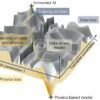National University of Singapore researchers have developed a machine-learning scheme that rapidly identifies previously unseen novel structures in disordered materials without human supervision. Their study was published in Science Advances.
Making sense of highly disordered complex materials is a long-standing challenge. A research team involving Assistant Professor Duane Loh from the Departments of Physics and Biological Sciences, and Professor Stephen Pennycook from the Department of Materials Science, both from the National University of Singapore, created a machine-learning framework that can learn the universal “vocabulary” and “grammar” to describe disordered systems. Using this framework, they discovered that a wide range of disordered materials can be logically decomposed into recurring motifs and their compositional rules. These motifs are the building blocks that can vastly simplify how we understand and even classify complex disorders in real materials.
Many forms of atomic-resolution microscopy let us peer into the secretive world of atoms whose arrangements create the wealth of materials that modern civilization relies upon. However, the way atoms in these materials arrange themselves under duress still remains a mystery. Unsurprisingly, these atomic arrangements are always imperfect and full of disorder. In fact, many materials are coveted because of properties derived from this disorderly arrangement.
Despite advances in machine-vision technologies, learning the rules for atomic arrangements from many atomic-resolution micrographs is still far from being automated. This is because of the challenges owing to the fragility of atomic arrangements to probing: limited signals from each atom; subtle and non-linear differences between atom types; and inevitable and empirical artifacts from experimental micrographs. Technically, these challenges make it difficult to build machine models for automated analyses. An unsupervised statistical learning technique would be needed, and this is a particularly thorny form of machine learning.
The research team used a sequence of mathematical expressions, known as Zernike-polynomials, to quantify the subtle structural and chemical features within atomic arrangements. These special mathematical expressions can effectively model the features despite different atomic orientations. To overcome the limited signal from each atom, the team generalized a single-particle imaging approach that automatically reveals distinct building blocks (i.e., motifs) within disordered materials. This approach is also sufficiently robust such that imaging artifacts do not affect the outcome.
Having learned the motifs from tens of thousands of atoms in an automated manner, the team could now discover how these motifs self-assemble into complex but disordered hierarchies. They found that some disordered materials can be described by only a handful of motifs; yet these few motifs create diverse structures because of complex motif-motif hierarchies. In comparison, some materials start with a continuous range of motifs, thus blurring the boundaries between their motif and hierarchies.
Prof. Loh said, “These motifs form a vocabulary of a disordered material, and the motif-motif hierarchies its grammar. This motif-plus-hierarchy description can meaningfully simplify our descriptions of disordered material. Fortuitously, this description has led to the discovery of a novel structure hidden within a highly disordered catalytic material.”
“The first author of this work, Dr. Jiadong Dan, is revisiting the micrographs from our collaborators and discovering many structural insights that were previously missed in the disordered materials,” added Prof. Loh.
Dr. Dan said, “I believe that this motif-plus-hierarchy scheme can be used to quantitatively classify the degree of disorder in material and will open the door to massive machine learning from atomic-resolution micrographs.”
The team hopes to turn this framework into a companion artificial intelligence application next to microscopes to rapidly make sense of disordered materials.
More information:
Jiadong Dan et al, Learning motifs and their hierarchies in atomic resolution microscopy, Science Advances (2022). DOI: 10.1126/sciadv.abk1005
Provided by
National University of Singapore
Citation:
Learning motifs and their hierarchies in atomic-resolution microscopy (2022, June 22)


